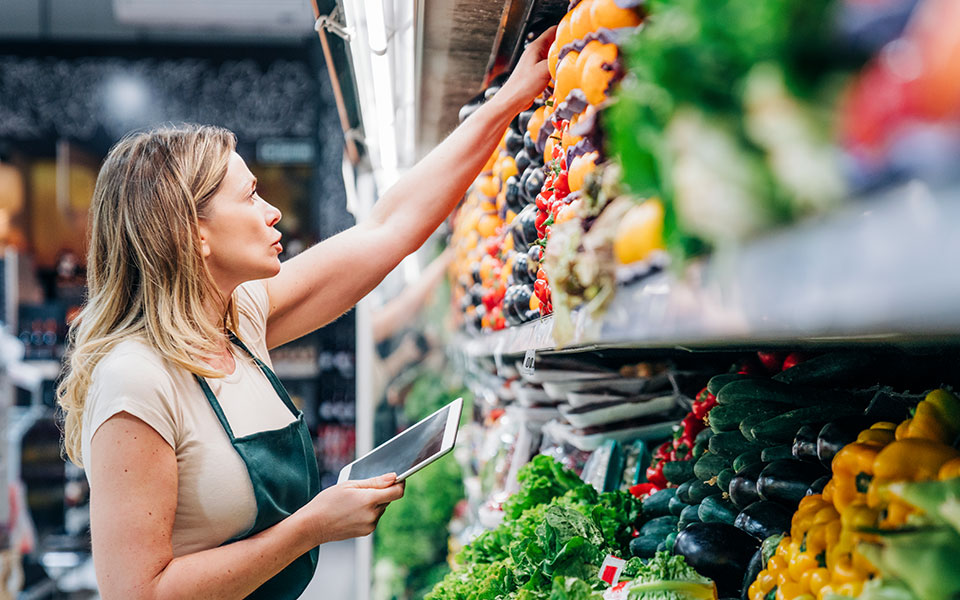*On June 1, 2023 Emerson’s Climate Technologies business became a new standalone company – Copeland. Though our name has changed, we are building on more than a century of HVACR innovation and industry leadership, and Copeland continues to offer the same products, industry stewardship, and learning opportunities you’ve grown to trust. Information found on this webpage posted before June 1, 2023 may contain our old name or branding, but you can be at ease knowing it was created with the knowledge and expertise of Copeland.
The cold chain in perishable food distribution is a complex and delicate thing. Just one hour out of optimum temperature range can have significant impact on a product’s shelf life. More serious cold chain lapses can pose waste, food safety and environmental issues, causing businesses and entire industries financial and reputational harm. At the E360 Forum in Houston last fall, I shared common cold chain pitfalls, real-world case studies and best practices for successfully navigating this complicated process. Read more below, then view the full E360 Forum presentation.

Those blueberries on your cereal? They’re from Chili. That orange? South Africa. Today’s food travels incredible distances to get to you. And behind your grilled salmon supper, there’s a dizzying array of complex cold chain management and monitoring that needs to happen to get it to your table — safe and tasty.
Industry experts say that from farm (or ocean) to your fork, there can be as many as 15–20 transfer points (hand-offs) in the cold chain process, encompassing trucks, containers and even planes. Each stop increases the risk of food safety incidences, spoilage and lost profits.
What’s at stake when the cold chain breaks?
Food and resource waste
One of the more frustrating things to me is the amount of time, money and resources spent producing food and getting it to where it needs to go — only to have it spoil by the time it gets to the point of sale. Think of all the work, expenses, fuel and greenhouse gas emissions it requires to get product from California to the East Coast. When there’s a break in the cold chain, all of that time, effort and money could potentially be lost.
According to Food Foolish by John Mandyck and Eric Schultz, the amount of food waste in the supply and distribution of food is staggering. They estimate that:
-
- 1 billion metric tons of food is lost or wasted each year
- One-third of food produced each year is never eaten
- 800 million people in the world are chronically hungry
In addition, food waste has a devastating impact on the environment in terms of water waste and the creation of greenhouse gases. Mandyck and Schultz go on to say: “If food waste were a country by itself, it would be the third-largest emitter of greenhouse gases behind China and the U.S.”
Financial impacts
I don’t need to tell you there’s big money in each trailer transporting food commodities across the country and around the world. If there’s a break in the cold chain, the financial impacts can be painful. Check out the food value estimate per truckload:
-
- Beef — $150,000 to $250,000
- Poultry — $60,000 to $225,000
- Pork — $80,000
- Strawberries — $20,000
- Bananas — $16,000
Food safety and public health
According to the CDC, about 48 million people (1 in 6 Americans) get sick, 128,000 are hospitalized, and 3,000 die each year from foodborne diseases. Not all issues are directly attributable to compromised cold chain processes. But with elevated temperatures, a very small situation can grow exponentially in a very short time. By properly managing temperature, you can mitigate and isolate a potential food incident before it can spread.
Conquering the cold chain
We know what can go wrong when temperatures aren’t right. But how can broken links in the cold chain be prevented? To answer that, here are a few best practices for facilitating good temperatures in transit.
-
- Start with appropriate pre-cooling processes. Remove field heat from product as soon as possible, pre-cool containers, and “pulp” or take product temperature to ensure it’s at the correct setpoint.
- Follow proper loading practices for optimal air circulation.
- Establish and communicate proper transport temperatures; pay attention to mixed loads.
- Employ independent temperature-monitoring devices and proper placement procedures.
- Check temperature history and place immediately into cold storage at the distribution center.
Transport from the distribution center to the retailer needs to be closely monitored as well. In fact, this is one of the areas where we see the most breakdowns: the transfer at the final point of sale. Deliveries typically come in very late and perishables are not put into cold storage quick enough.
Baked bananas and blockchain
One of our customers recently shared a story about a load of bananas they received. The retailer was using one of our real-time monitoring devices and knew before the containers were unloaded that bananas had basically cooked in transit. Armed with real-time temperature data, they declined the shipment, saving $28,000 on two loads — loads they may have previously accepted.
Digital time and temperature loggers, real-time trackers with proactive alerts have been a part of perishable loads in transit for years. As illustrated by the story above, they have been instrumental in identifying temperature flux and allow retailers and suppliers to be more preventive and proactive.
Emerson is leading exciting developments in analytics based on aggregated data from these devices. Vast amounts of in-transit time, location and temperature intelligence are now stored in the cloud — and can be tapped for deeper cold chain insights on best routes, carriers, shipping lanes and suppliers.
Another technology getting a lot of industry buzz is blockchain. (It’s not just for cryptocurrency.) Blockchain offers an incredibly secure platform to share deep and detailed data across all the supply chain players. It lets disparate, previously siloed, entities share common, unalterable data on a common framework. We’re currently working with IBM to create food freshness applications and shelf-life predictors that could be shared across the blockchain platform. And that’s only the beginning.
To hear more best practices, cold chain success stories and even a few cautionary tales, be sure to view the full E360 Forum presentation here.

8 proven strategies for rigorous cold chain management
Preparing for the approval and safe use of A2Ls in commercial refrigeration applications...
Protection for high-value shipments just got even better
We’re excited to announce the release of Copeland’s newest real-time tracker, the GO Real-Time...

Three proven strategies to prevent cargo theft
The over-the-road (OTR) transport industry is experiencing a surge in cargo thefts. As thieves...
